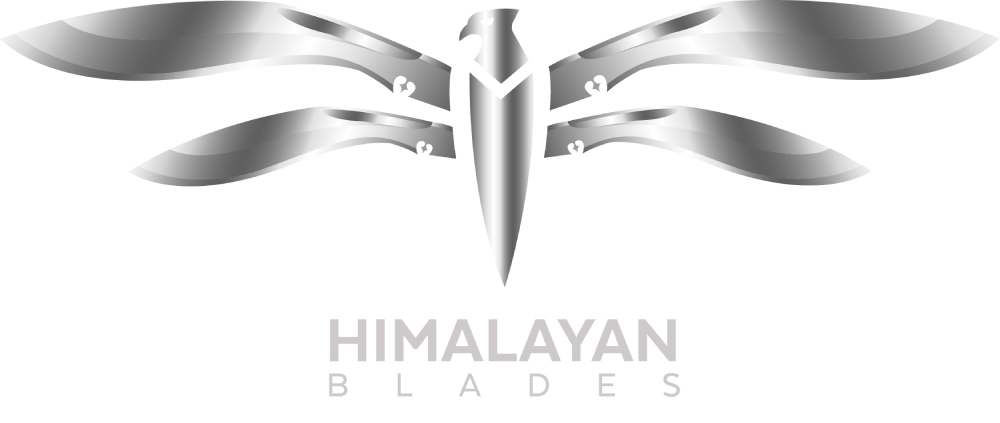6 Traditional Kukri Knife Types You Need To Know About
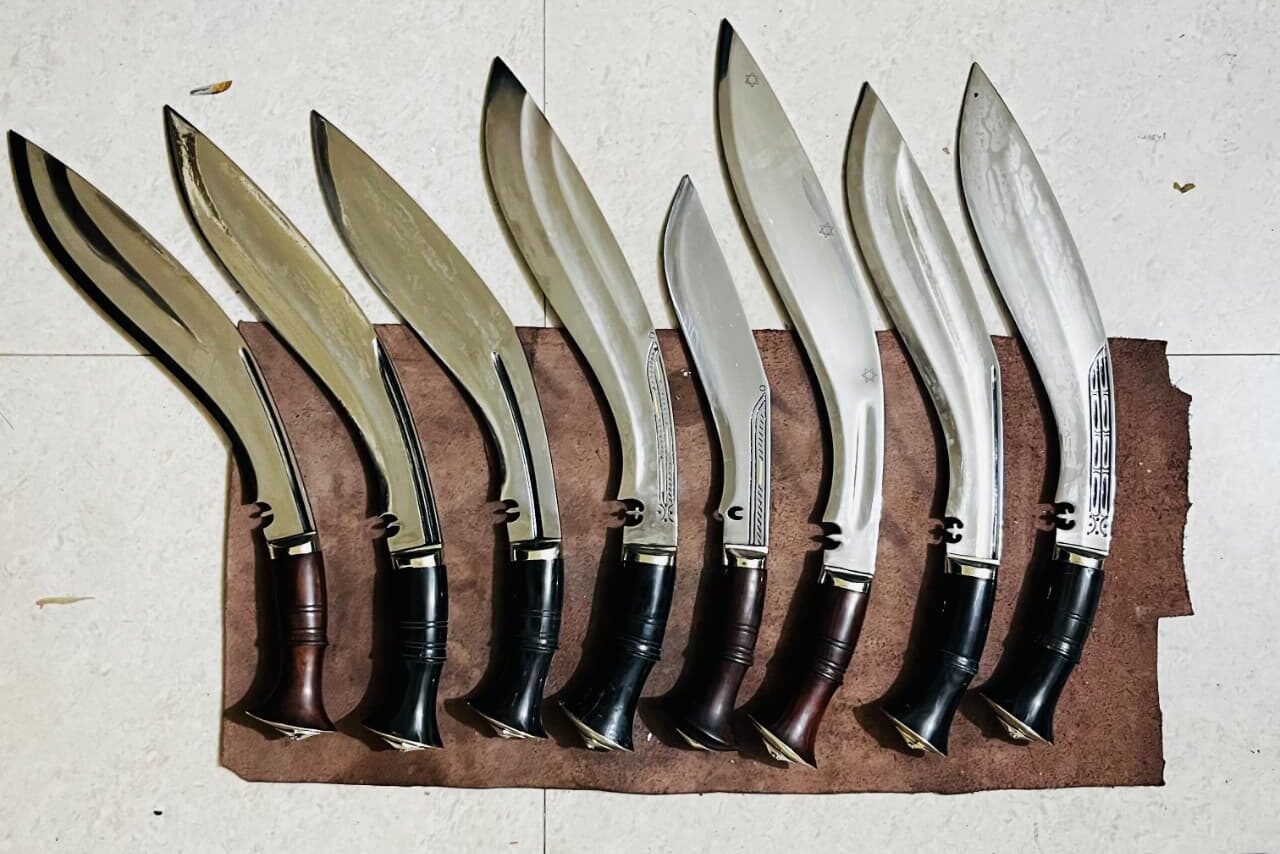
I vividly remember holding a Kukri knife for the first time and instantly understanding its well-deserved reputation. The curve of the Kukri knife is not merely ornamental. It serves to enhance the allure of the strikes, and even a novice is armoured with a sense of dominance and control with these knives.
I have seen Kukris in usage in domestic kitchens while preparing meat, in rural areas for splitting logs, and even in military formations during a parade with the insignia of the military. The biggest astonishment, however, was the revelation that not all Kukris are the same.
There is no single definition for the term “traditional kukri knife.” Instead, there are various types that are regional and functional, all of which are engrained in history and shaped by geography and necessity. Others, however, were made purely for warfare, base pursuits, and some were even made for ceremonial occasions, which are rich in cultural heritage.
I grew to appreciate the Kukri knife by reading history, handling replicas, speaking with collectors and craftsmen, and running my own kukri house, Himalayan Blades. In this piece, I will share the six most traditional types of Kukri knives.
Hanshee Kukri Knife – The Warrior’s Blade
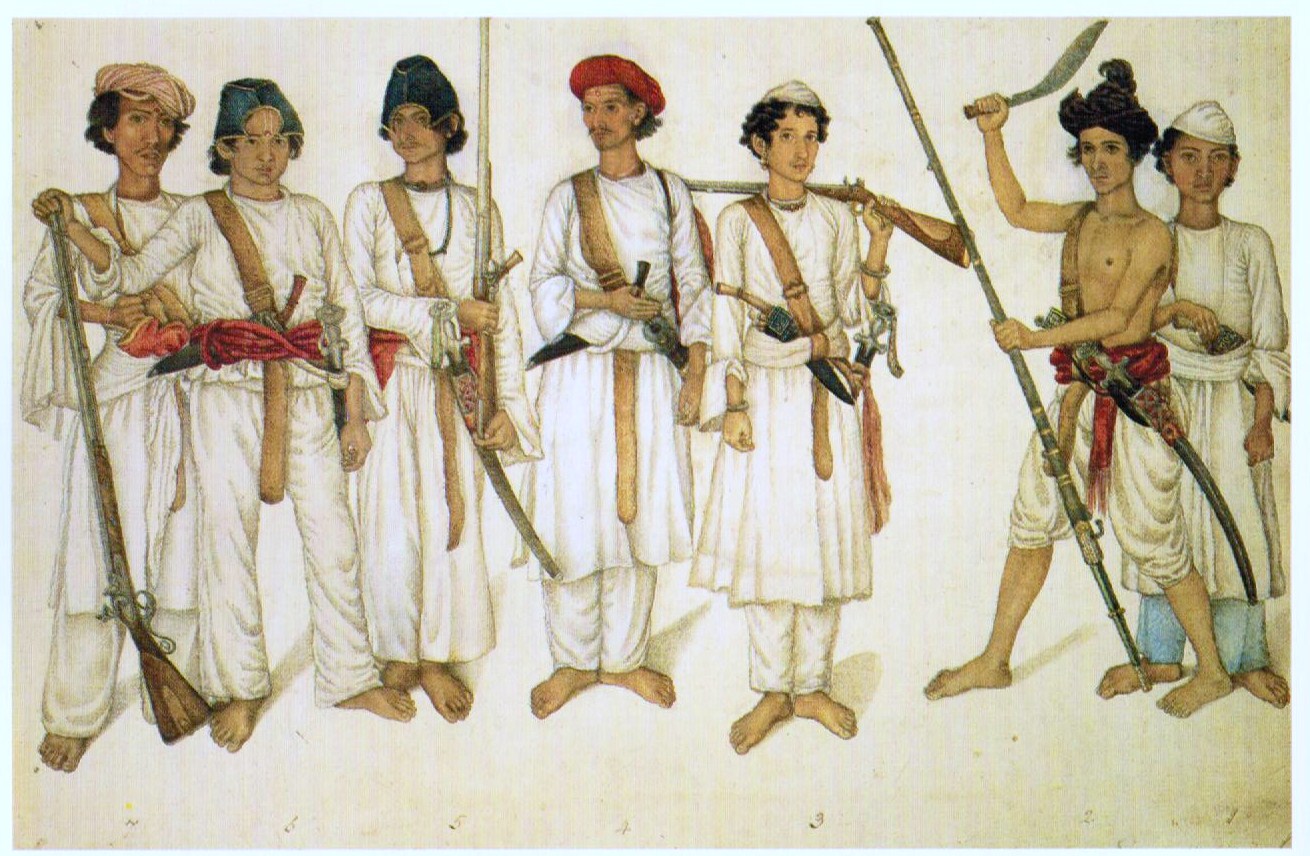
The Hanshee kukri knife is distinctive from the onset. Its handle, almost sculpted, hangs proportionately longer than most. The kukri blade is slim and perforated with steep obesities. While most kukris hover between honest weaponry and utilitarian tool, the Hanshee appears to have been made with one purpose and one purpose only: WAR.
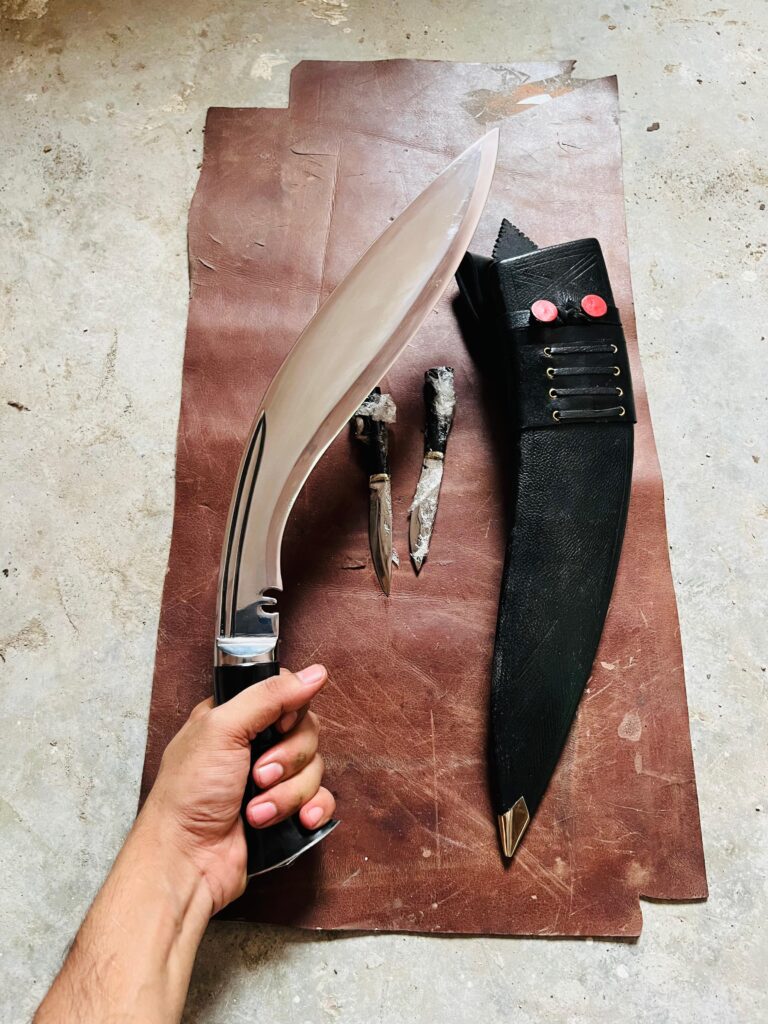
The first Hanshee I encountered was during an exhibit, and I was simply spellbound. The curve was so exaggerated that, to me, it came across as so eager to attack. This was no village chopping knife, and, indeed, was a war blade.
Many historians point out that between the sixteen and nineteen hundreds, the Hanshee kukris came into circulation. Even pieces that King Dravya Shah is credited with, who many believed lived in the mid 1500’s, are assumed to be at least a century off and belong in the late 1700’s, or, even worse, early 1800’s. What we do know about the weapon, however, is that Gurkhas had already begun practicing with it, even during the last confrontations with the British in 1800.
The Fraser Album (1815) vividly depicts Gurkhas wielding long-handled kukris, most likely Hanshee kukri knives. They did not carry these blades for farming — they wielded them to deliver deadly, rapid slashes in close combat.
Today, only a few collectors own authentic Hanshee Kukris. If you happen to hold one, you will feel the unusual long handles that provide so much leverage. It is also a testament of the power of the empires that used the kukri.
Bhojpure Kukri Knife – The Heavy Chopper
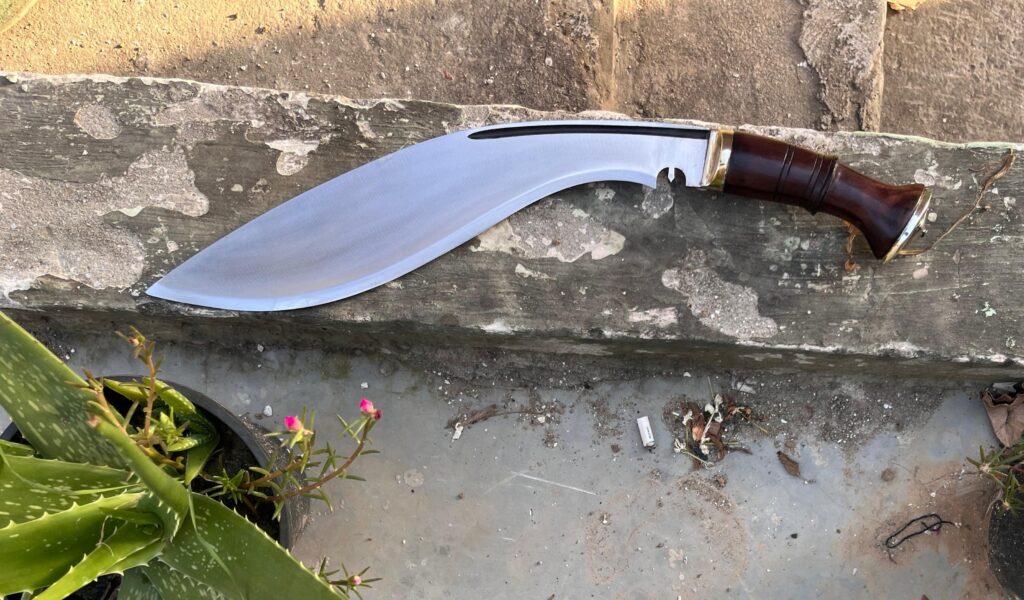
Most of the Hanshee Kukris are elegant pieces. This can’t be said for Bhojpure Kukri Knife of Bhojpur in eastern Nepal. It is an instantly recognizable piece that is broad, heavy, and built to chop.
I tested the reproduction of a Bhojpure Kukri on a large piece of hardwood, and the outcome was shocking. One strike with the Bhojpur fell deeper within the wood than any regular machete after three swings. That is the beauty of the design. A Bhojpure Kukri knife may come in matte, polished, or forged finishes, usually 13 to 15 inches long. Unlike other Kukris, it has little curve but a wide, fat belly that makes it easy to recognize.
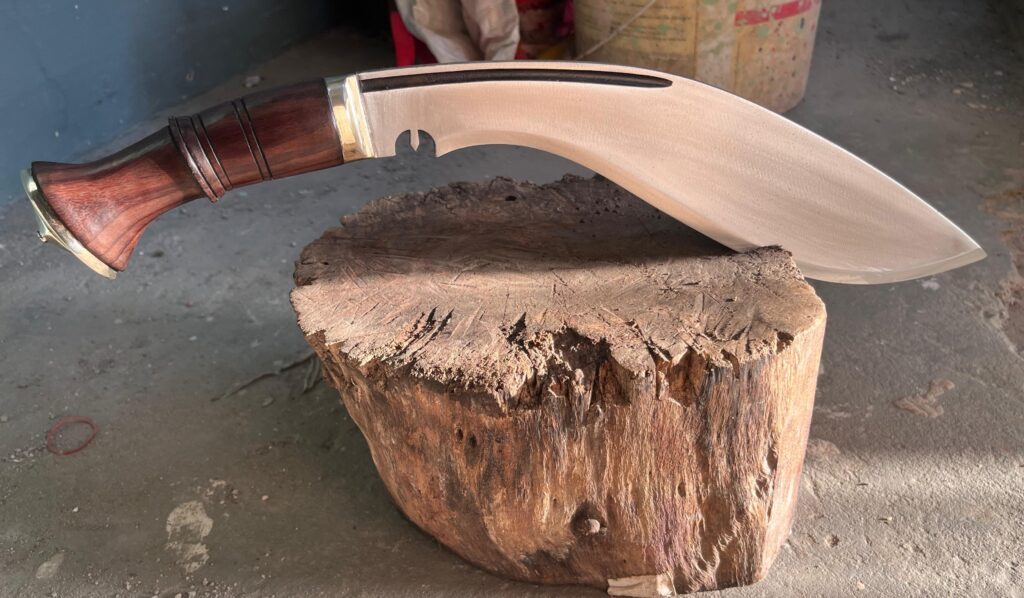
History
Before the 18th century, Bhojpure Kukris were renowned across Nepal. Warriors of the Kirat dynasty carried them as their primary weapons. In 1970, King Mahendra visited Bhojpur and praised Bhojpure Kukris as the finest in Nepal. It is thought and believed that the Kukris get their name from the Bhoj Patra tree that grows in the region as well as the word Bhoj, meaning ‘feast,’ as a result of chieftain Shah’s victory.
It is, during the time of the Kirat dynasty, that the Kukris came to be used and known across the country, and during the expansion of the Shah kingdom, in weapons and warfare as well. After that time is when the Kukris and their craftsmanship started to gain popularity as well. Blacksmiths shaped the Kukris we know today through centuries of change. The original, and early versions known as the Bhojure Kukris, were said to be intimidating in size and stature and thus, the perfect weapon. However, as the years progressed, and the 1960s came along in particular, and firearms came to take over the battlefield, the weapons lost their stature and became a common household item used to chop firewood, clear fields, or in some cases, slaughter animals.
If you want a sturdy Kukri today that is able to chop and split firewood and branches of a thick size, the traditional and reliable option is the Bhojpure.
Military Standard Issue Kukri Knife – The Gurkha Military Legacy
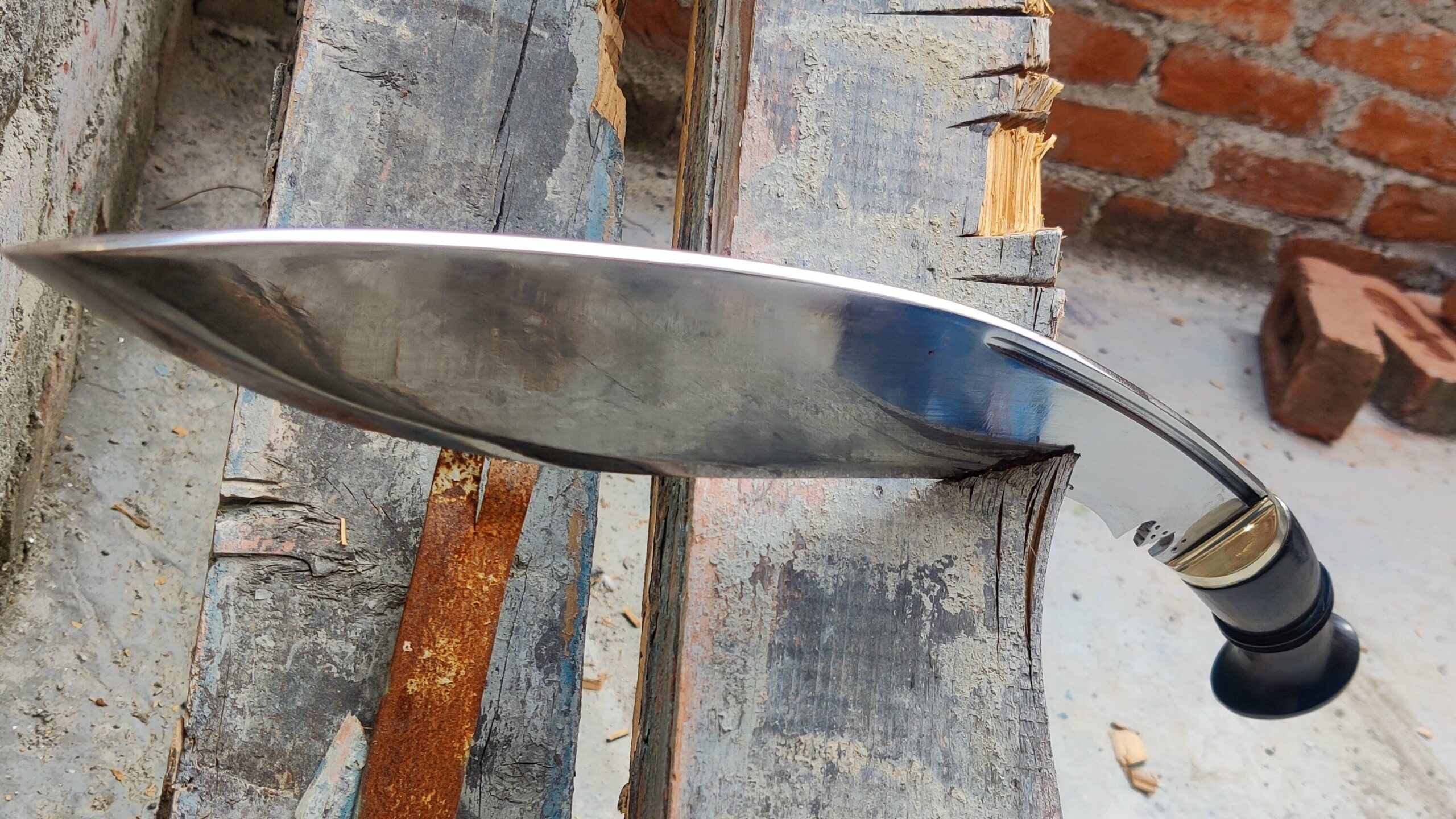
Any type of discussion involving kukri knives will certainly include the military standard-issue kukri knife. These are the blades caricature artists conjure when they hear the words Gurkha kukri – the primary issue blades for the soldiers of the Brigade of Gurkhas.
I first touched a replica of the MK2 Khukuri model, and as I was appreciating the craftsmanship, I especially admired its balance. In comparison with the Bhojpure, which feels positively like an axe, the MK2 kukri knife actually has a perfect disposition for utility or combat tasks. That was the objective! Soldiers had rifles and equipment, so the kukri had to be comparatively lighter, smaller, and easy to belt.
The standard-issue kukri has undergone a series of redesigns:
MK1 – early 1900s, was heavy and thick-spined, and had a commanding presence.
MK2 was a sleeker design and the most widely produced as it introduced a full flat tang and the full spined kukri for maximum strength.
The M43 is a WWII version of the MK2 that has a slight curve to the blade.
MK3 and MK4 kukri have a further refined design for portability and consistency.
Little Fact
BSI is the Gurkha kukri which is both ceremonial and functional, in use today. Here’s a surprising fact: when Gurkha kukris entered mass production, manufacturers focused on cost and simplicity instead of craftsmanship. The cheapest house with the simplest design won the contract, and that’s how the BSI kukri came into being. The BSI kukri has a reduced curve and belly, often lacks a full flat tang, and comes with shiny, low-grade leather. In short, some of the “standard issue” kukris are shaped more by production budgets than by the practical, time-tested features that made older kukris legendary.
What’s fascinating is how all these models integrate history with practicality. A kukri knife is not only viewed as a weapon in a Gurkha’s arsenal, but also as a highly versatile tool. For soldiers, they could be used to excavate trenches, prepare meals, or even unbox crates. In combat, however, it still served as a deadly sidearm.
For collectors, a genuine military-issue kukri allows them to to tap into the heritage of one of the most revered fighting forces in the world. It is the military kukri that captures how tradition shifts to accommodate the new without entirely losing its spirit.
Chainpure Kukri Knife – Lite and Versatile
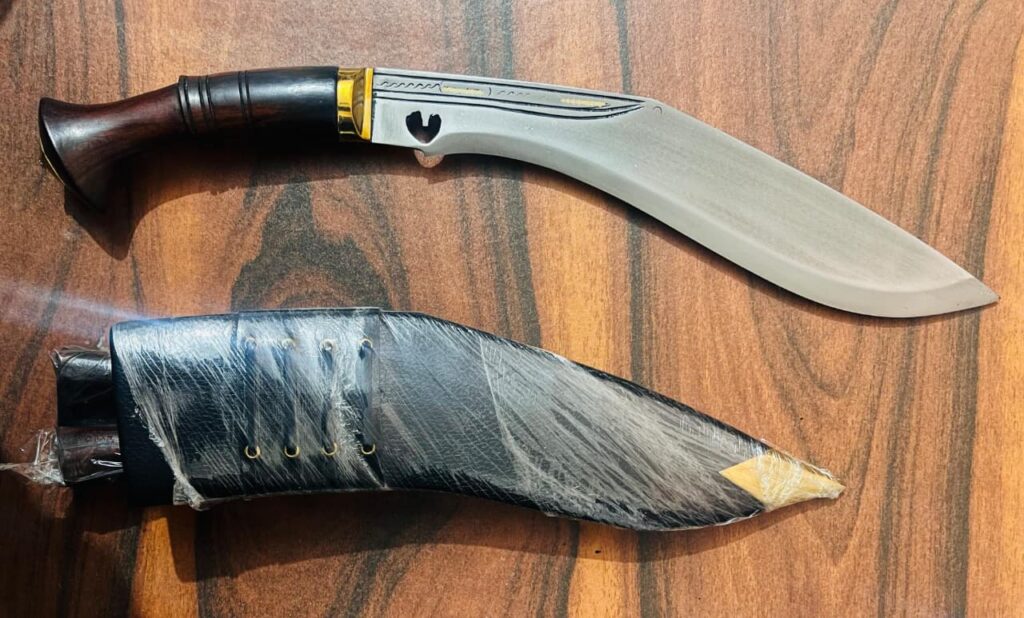
The difference in weight and ease of use between the bhojpure and Chainpure kukri knife is striking. This Chainpure kukri is named after the Chainpur town in eastern Nepal, for its light and narrow design, plus the fact that it is built for casual wear.
The Chainpure became special to me during a hike in the hills. Carrying an ordinary sword can be burdensome, but the Chainpure’s slim design is less tiring. It served the practical affairs of life for farmers and villagers, cutting, peeling, and clearing, as well as slicing vegetables and bark.
The focus of the Chainpure’s uniqueness is the notch design. Instead of the usual half-circle notch, it has a carved hole shaped like a cow’s hoof. Hindus regard it as sacred and believe it brings luck. Some also view it as holding the blade above and representing the Lord Shiva’s “Om” symbol.
Domestic Features
The blade itself is generally around 10 inches long, narrow, tapered to a point, and often embellished with light decorative elements. The blade’s handle is also distinct: it has a flare at the bottom and is often equipped with a “V” shaped keeper instead of the standard metal cap, giving it a stronger grip.
The Chainpure is not as old as the Bhojpure or Hanshee. It first appeared in the 1950s and gained popularity in the 1990s when the kukri market grew rapidly. Even so, it is now one of the most celebrated examples of traditional design, especially among enthusiasts of lighter and faster blades.
The Chainpure kukri serves the villagers for construction, farming, and other daily chores. Knife collectors prize it for its practicality and unique beauty.
Limbuwan Kukri Knife – The Blade of the Eastern Warriors
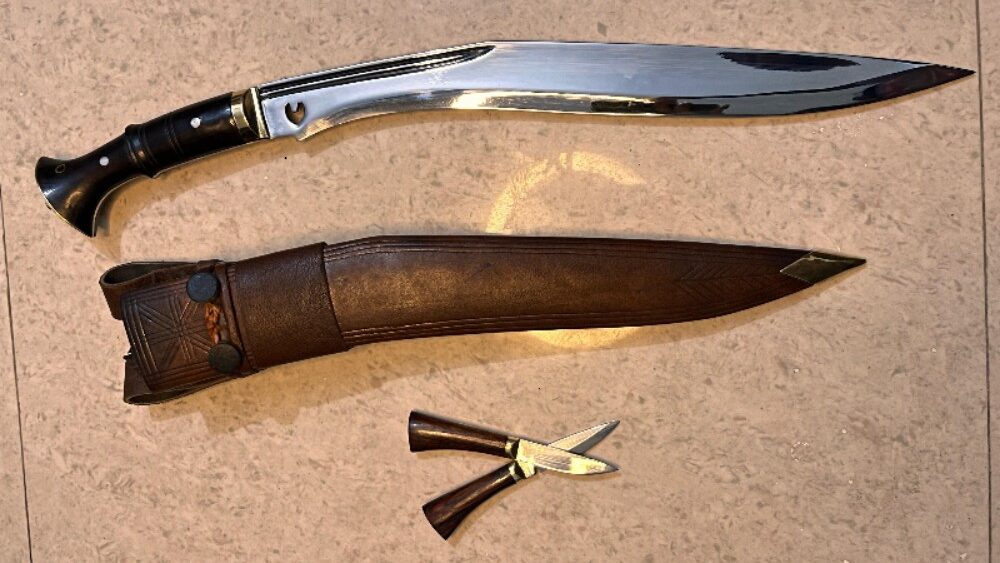
The Limbuwan kukri connects deeply to the history of the Limbu community in eastern Nepal. Forged more as a weapon of war than as a farming tool, this blade carries a long, narrow, and sharp profile, designed for the battlefield. Unlike the heavy curves of other kukris, the Limbuwan features a straighter line, resembling the sleek style of the Sirupate.
The Kukri also represents the identity of the Kirati people — the Rai, Limbu, and Sunuwar. Many served in Gurkha regiments in the 19th and 20th centuries. In both World Wars, soldiers from eastern Nepal carried their own regional Kukris, often the slender Sirupate or the Limbuwan design.
Built for combat, the Limbuwan kukri offers longer reach, a thinner blade, and a natural slashing ability. Unlike the Bhojpure, which relies on heavy chopping power, the Limbuwan feels closer to a dueling sword — swift, precise, and deadly in skilled hands.
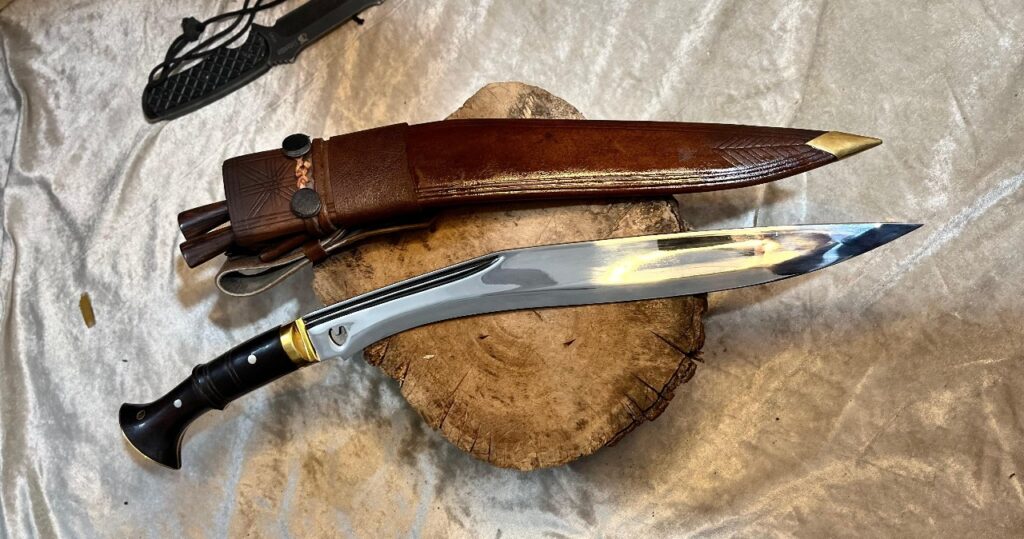
Decorated Kirati Gurkha soldiers such as Naik Agan Sing Rai and L-Cpl Ram Bahadur Limbu carried this design, which gives it historical weight. The Limbuwan kukri depicts the indomitable spirit of eastern Nepal. It is not used as widely today, but is as a cultural symbol, a piece of history, and a treasured collectible.
Angkhola Kukri Knife – The Heavy-Duty Workhorse
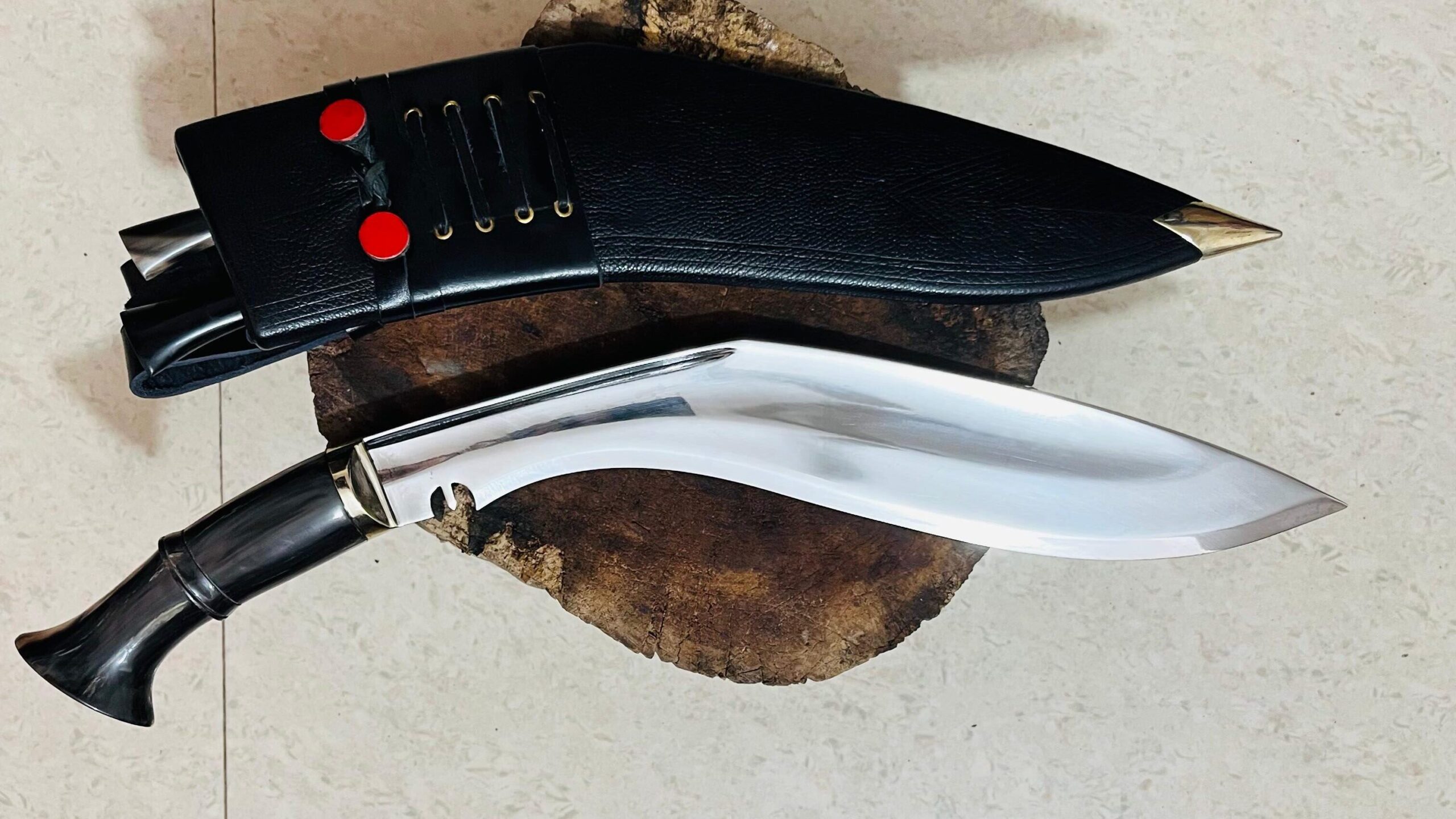
The Angkhola kukri knife, often called the “axe-kukri,” earns its name the moment you use it to split firewood. Its distinctive fuller grooves lighten the blade while absorbing shock on impact. Imagine swinging a solid blade into a log — without those grooves, the jolt would run straight into your wrist. With the Angkhola’s design, the force disperses, making it far more comfortable for extended use.
Traditionally, Angkhola kukris served both in combat and in daily chores. I once had the chance to handle a replica of a 1910 piece owned by a British officer, and the craftsmanship left me in awe. The double fullers gave the blade remarkable strength while keeping the weight manageable — a perfect balance of power and practicality.
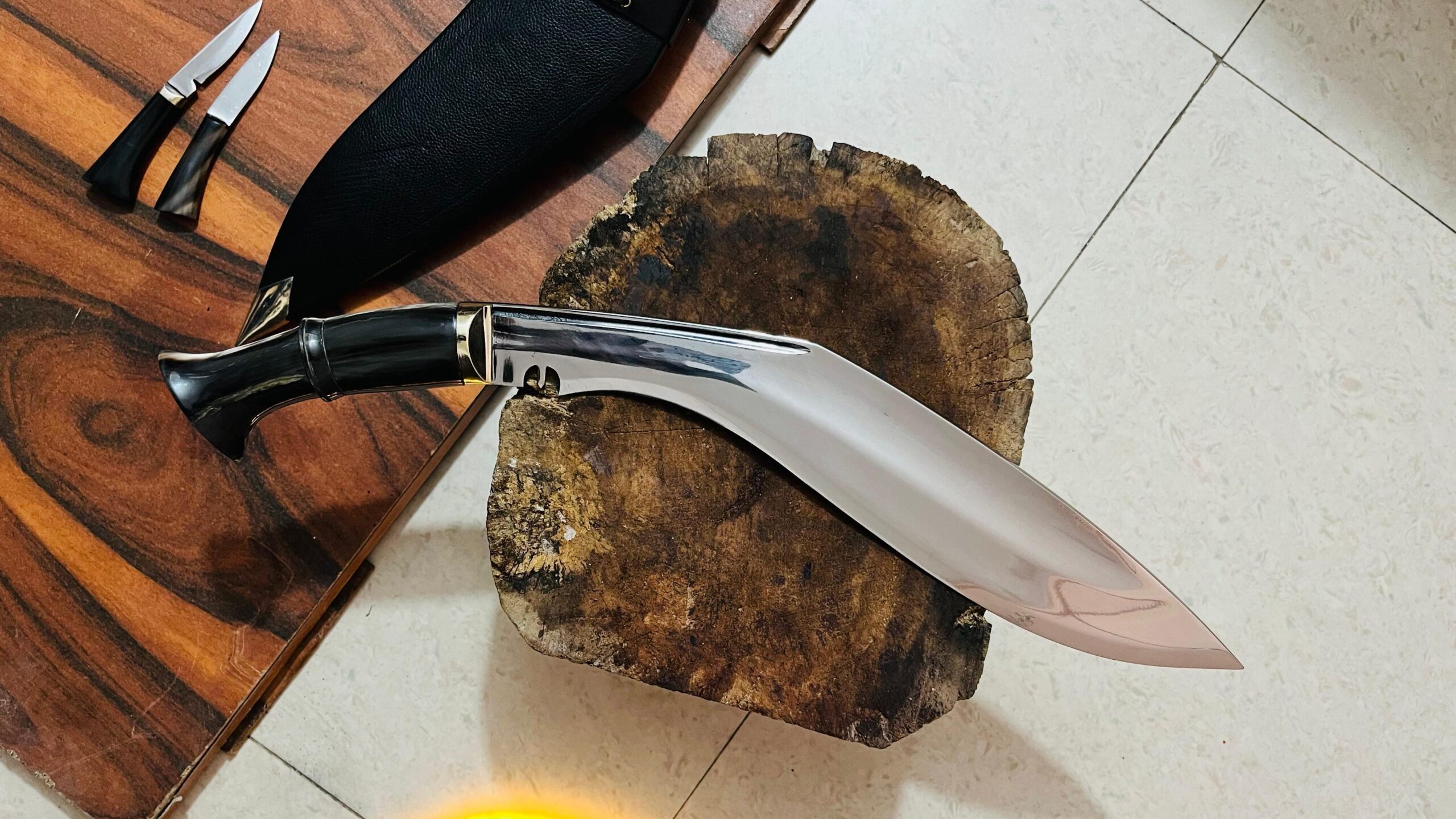
The words ang and khola together translate to carved out body. This functionality adds to the beauty of the blade. Master blacksmiths carved deep, dark grooves into the blade, showing their skill against the polished steel.
Closing Remarks
To say that the kukri knife is the same as “the blade of the Gurkhas” is to greatly simplify it. Each type of kukri knife is a part of a living tradition. It is used for a multitude of activities ranging from cooking and ritual, to as a weapon in war, or a necessity for everyday tasks. Watch lot of such content here.
- The Hanshee Kukri reflects the weapon’s earliest identity — a blade forged purely for combat and the warrior’s hand.
- The Bhojpure Kukri stands as a testament to raw chopping power, embodying the strength and craftsmanship of Nepal’s villages.
- The Military Kukri links the knife to the legendary Gurkha regiments, where history and battlefield valor shaped its legacy.
- The Chainpure Kukri transforms an everyday utility blade into a symbol of culture, spirituality, and practical elegance.
- The Limbuwan Kukri carries the spirit of Nepal’s eastern warriors, connecting the blade to centuries of martial tradition.
- The Angkhola Kukri showcases functional innovation, blending striking design with unmatched durability and performance.
To see these six Kukri knives only as blades would be an oversimplification. Each type reflects culture, geography, and purpose, turning them into lasting symbols. Collectors, martial artists, and history enthusiasts alike will find that these Kukri types enhance understanding of this knife that is rooted in fable and folklore. Learn about the origin of Kukri.
